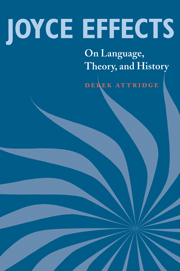Book contents
- Frontmatter
- Contents
- Acknowledgments
- References and abbreviations
- Preface
- Introduction: On being a Joycean
- Chapter 1 Deconstructive criticism of Joyce
- Chapter 2 Popular Joyce?
- Chapter 3 Touching ‘Clay’: reference and reality in Dubliners
- Chapter 4 Joyce and the ideology of character
- Chapter 5 ‘Suck was a queer word’: language, sex, and the remainder in A Portrait of the Artist as a Young Man
- Chapter 6 Joyce, Jameson, and the text of history
- Chapter 7 Wakean history: not yet
- Chapter 8 Molly's flow: the writing of ‘Penelope’ and the question of women's language
- Chapter 9 The postmodernity of Joyce: chance, coincidence, and the reader
- Chapter 10 Countlessness of livestories: narrativity in Finnegans Wake
- Chapter 11 Finnegans awake, or the dream of interpretation
- Chapter 12 The Wake's confounded language
- Chapter 13 Envoi: judging Joyce
- Works cited
- Index
Chapter 10 - Countlessness of livestories: narrativity in Finnegans Wake
Published online by Cambridge University Press: 22 September 2009
- Frontmatter
- Contents
- Acknowledgments
- References and abbreviations
- Preface
- Introduction: On being a Joycean
- Chapter 1 Deconstructive criticism of Joyce
- Chapter 2 Popular Joyce?
- Chapter 3 Touching ‘Clay’: reference and reality in Dubliners
- Chapter 4 Joyce and the ideology of character
- Chapter 5 ‘Suck was a queer word’: language, sex, and the remainder in A Portrait of the Artist as a Young Man
- Chapter 6 Joyce, Jameson, and the text of history
- Chapter 7 Wakean history: not yet
- Chapter 8 Molly's flow: the writing of ‘Penelope’ and the question of women's language
- Chapter 9 The postmodernity of Joyce: chance, coincidence, and the reader
- Chapter 10 Countlessness of livestories: narrativity in Finnegans Wake
- Chapter 11 Finnegans awake, or the dream of interpretation
- Chapter 12 The Wake's confounded language
- Chapter 13 Envoi: judging Joyce
- Works cited
- Index
Summary
Most readers of Finnegans Wake would probably hesitate to call it a novel, and one of the reasons for this reluctance is that it lacks anything that could unproblematically be called a narrative, something which even such exceptional texts as Tristram Shandy and Ulysses, for all their oddity, can be said to possess. Yet narrative is hardly absent from the Wake; indeed, in the words of the text itself, at one of its many auto-descriptive moments, ‘Countlessness of livestories have netherfallen by this plage, flick as flowflakes, litters from aloft, like a waast wizzard all of whirl-worlds’ (FW 17.26). Finnegans Wake is a great mound of stories, a gigantic accumulation of the world's narratives, but it seems that it is not one of them.
To explore this paradox, it will help to establish a working definition of narrative: let us say that it is a linear (though often multilevelled) account of recognizable characters and events, engaging with the reader's pre-existing mental schemata to arouse expectations, and to modify, complicate, defeat, or partially satisfy those expectations, arriving at full satisfaction – or something like it – only at the end (thereby constituting it as the end). Individual narratives work in different ways to produce pleasure and perhaps some form of understanding or insight, but what they all have in common is the condition of being narratives, of engaging with the world and the mind in the specific manner of narrative.
- Type
- Chapter
- Information
- Joyce EffectsOn Language, Theory, and History, pp. 126 - 132Publisher: Cambridge University PressPrint publication year: 2000



